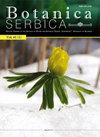杜鹃科植物叶绿体全基因组序列的结构比较与系统发育分析
IF 1.1
4区 生物学
Q4 PLANT SCIENCES
引用次数: 0
摘要
杜鹃花(杜鹃花科)具有宝贵的园艺和药用价值。然而,关于红毛鼠的基因组信息非常有限。本研究对红枣叶绿体全基因组(cp)进行了组装和注释,对SSR位点进行了鉴定,并进行了比较基因组分析和系统发育研究。结果表明,该基因为典型的四分体结构(200,997 bp)。大单拷贝区(LSC)、反向重复区(IR)和小单拷贝区(SSC)的长度分别为109,151 bp、2,604 bp和44,619 bp。共鉴定出147个独特基因,其中蛋白质编码基因99个,tRNA基因42个,rRNA基因6个。亮氨酸(11.51%)和半胱氨酸(1.15%)分别为最高和最低的代表性氨基酸。30个密码子使用偏差明显的密码子均为A/ u端密码子。在77个简单序列重复序列中,大多数是位于基因间间隔区的单核苷酸A/T重复序列。5个基因区域显示出高水平的核苷酸多样性(Pi >0.03)。比较基因组分析发现了7个热点基因间区(trnI-rpoB、trnTrpl16、rpoA-psbJ、rps7- rn16、ndhI-rps16、rps16-rps19和rrn16-trnI),具有作为物种鉴定分子标记的巨大潜力。红豆cp基因组IR区存在扩增和收缩现象。在系统进化树中,金银花与扁桃花亲缘关系较近。这一研究成果将为进一步研究云杉科植物及其近缘种的进化和遗传多样性奠定基础。本文章由计算机程序翻译,如有差异,请以英文原文为准。
The complete chloroplast genome sequence of Rhododendron fortunei: Structural comparative and phylogenetic analysis in the ericaceae family
Rhododendron fortunei (Ericaceae) possesses valuable horticultural and medicinal values. However, the genomic information on R. fortunei is very limited. In this study, the complete chloroplast genome (cp) of R. fortunei was assembled and annotated, SSR loci were characterised, comparative genomic analysis was carried out, and phylogenetic research was also performed. The results showed that the R. fortunei cp genome was of a typical quadripartite structure (200,997 bp). The lengths of the large single copy region (LSC), the inverted repeat regions (IR), and the small single copy region (SSC) were 109,151 bp, 2,604 bp, and 44,619 bp, respectively. A total of 147 unique genes were identified, including 99 protein-coding genes, 42 tRNA genes, and 6 rRNA genes, respectively. Leucine (11.51%) and cysteine (1.15%) were the highest and lowest representative amino acids, respectively. The total of 30 codons with obvious codon usage bias were all A/U-ending codons. Among the 77 simple sequence repeats, the majority were mononucleotide A/T repeats located in the intergenic spacer region. Five gene regions showed high levels of nucleotide diversity (Pi > 0.03). The comparative genome analysis revealed 7 hotspot intergenic regions (trnI-rpoB, trnTrpl16, rpoA-psbJ, rps7-rrn16, ndhI-rps16, rps16-rps19, and rrn16-trnI), showing great potential as molecular makers for species authentication. Expansion and contraction were detected in the IR region of the R. fortunei cp genome. In the phylogenetic tree, R. fortunei was closely related to R. platypodum. This research will be beneficial for evolutionary and genetic diversity studies of R. fortunei and related species among the Ericaceae family.
求助全文
通过发布文献求助,成功后即可免费获取论文全文。
去求助
来源期刊

Botanica Serbica
Agricultural and Biological Sciences-Plant Science
CiteScore
1.40
自引率
12.50%
发文量
17
审稿时长
34 weeks
期刊介绍:
Botanica Serbica publishes original research papers on all aspects of plant, fungal and microbial biology research including the disciplines of microbiology, mycology, lichenology, bryology, flora, vegetation, biogeography, systematics, taxonomy, plant biotechnology, plant cell biology, plant ecology, environmental plant biology, forestry, genomics, horticulture, limnology, metabolomics, molecular biology, proteomics, virology, plant conservation and protection, and wildlife and ecosystem management.
 求助内容:
求助内容: 应助结果提醒方式:
应助结果提醒方式:


